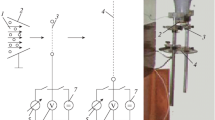Abstract
Results of experimental investigations performed on 210–1200 MWel. power units at thermal and nuclear power stations yielded a statistical correlation of the corrosion rate for cooled copper conductors in water-cooling systems of the stator winding in a hydrogen-water cooled generator vs. cooling water quality characteristics, such as electrical conductivity, pH, and dissolved oxygen content. The content of dissolved oxygen in the cooling water is found to have a pronounced effect on the efficiency of corrosion protection of system elements. An engineering solution is proposed. It calls for installation of a small cavitation deaerator operating on superheated water in the cooling water return pipeline from the turbogenerator stator winding to a vacuum tank from which steam is removed by the main ejector of the turbine unit condenser or the deaerator’s own ejector. Special experimental investigations allowed the determination of the water deaeration efficiency in deaerators of the considered type. It is described by a dependence of a relative decrease in the content by weight of oxygen dissolved in the deaerated water on the water overheating at the deaerator inlet with reference to saturation temperature corresponding to the pressure in the steam suction pipeline. It was established by calculations that the proposed engineering solution decreased the corrosion rate of copper conductors in water-cooling systems of the stator winding, on average, by a factor of 2.1. Results of this investigation can be used in designing new power facilities or retrofitting process systems of operating hydrogen-water cooled turbogenerators.
Similar content being viewed by others
References
E. I. Gurevich and A. G. Filin, “The temperature field of the stator winding of a powerful turbo-generator with local disturbances of internal water-cooling system,” Elektrichestvo, No. 3, 23–29 (2010).
G. M. Fedorenko and A. V. Vygovskii, “Efficiency of water treatment in direct cooling systems of stator windings of powerful turbo-generators and its impact on safety, reliability and efficiency of NPP units,” Tr. Inst. Elektrodin. Nats. Akad. Nauk Ukrainy, No. 30, 62–68 (2011).
V. V. Shevchenko, “Ways of defect development prevention in the elements of turbo-generators,” Vestn. Priazovskogo Gos. Tekh. Univ. Tekh. Nauki, No. 32, 172–180 (2016).
“Operational circular Ts-10-85 (E). On the organization of water-chemistry of a cooling system for stator windings of turbo and hydro generators,” in Collection of Decisions and Circulars of GTU Minenergo SSSR of 1985 (electric engineering part) (Soyuztekhenergo, Moscow, 1986) [in Russian].
V. E. Gmurman, Fundamentals of Probability Theory and Mathematical Statistics (Vysshaya Shkola, Moscow, 2003, 9 ed.; Elsevier, New York, 1968).
A. S. Ivanov, E. M. Shitov, and A. V. Bogachev, “Corrosion of hollow copper conductors in direct water cooling systems of turbogenerator windings,” Universum: Tekh. Nauki, No. 11, 20–24 (2016).
V. I. Sharapov and D. V. Tsyura, Thermal Deaerators (Ul’yanovsk. Gos. Tekh. Univ, Ul’yanovsk, 2003) [in Russian].
V. I. Sharapov and V. E. Makarova, “On direct-flow vacuum deaerators,” Energosberezhenie Vodopodgot., No. 3, 42–44 (2006).
G. V. Ledukhovskii, V. N. Vinogradov, I. A. Shatova, and A. A. Razinkov, “Reconstruction of atmospheric jet deaerators using AVACS cavitation deaeration devices,” Vestn. Ivanov. Gos. Energ. Univ., No. 6, 5–10 (2014).
B. A. Zimin, “Problems of water deaeration in power engineering and a way to solve them,” Nov. Teplosnab., No. 1, 40–44 (2006).
E. V. Barochkin, V. P. Zhukov, G. V. Ledukhovskii, and A. A. Borisov, “Generalized calculation method for multi-stage deaerators,” Izv. Vyssh. Uchebn. Zaved., Ser.: Khim. Khim. Tekhnol. 47 (9), 100–103 (2004).
Author information
Authors and Affiliations
Corresponding author
Additional information
Original Russian Text © G.V. Ledukhovsky, Yu.E. Barochkin, V.P. Zhukov, V.N. Vinogradov, I.A. Shatova, 2018, published in Teploenergetika.
Rights and permissions
About this article
Cite this article
Ledukhovsky, G.V., Barochkin, Y.E., Zhukov, V.P. et al. Water Deaeration in Water-Cooling Systems of the Stator Winding in a Turbogenerator with Hydrogen-Water Cooling. Therm. Eng. 65, 751–755 (2018). https://doi.org/10.1134/S004060151810004X
Received:
Accepted:
Published:
Issue Date:
DOI: https://doi.org/10.1134/S004060151810004X




